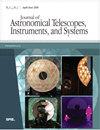将线发射测绘仪的高分辨率 X 射线光谱学扩展到紫外/光亮源
IF 3.1
3区 工程技术
Q2 ENGINEERING, AEROSPACE
Journal of Astronomical Telescopes Instruments and Systems
Pub Date : 2024-03-01
DOI:10.1117/1.jatis.10.1.014006
引用次数: 0
摘要
线发射绘图仪 X 射线探测器级飞行任务的概念是基于一个微量热计阵列,其能量范围为 0.1 至 2 千伏。对宇宙生态系统的研究确定了线发射绘图仪(LEM)任务的定向部分,因此 LEM 已针对观测漫射 X 射线发射气体进行了优化,这些气体大多表面亮度很低。为了扩大普通观测者可以利用 LEM 研究的目标范围,我们对紫外线/光学明亮恒星和太阳系天体的特殊需求进行了调查。X 射线微量热仪容易受到能量分辨率下降的影响,而能量分辨率下降可能是由于残余紫外线、光学和红外辐射的热噪声造成的。利用微量热计热滤波器的现有基线设计,我们计算了有效温度范围在 3500 至 39,000 K 之间的明亮恒星和太阳系天体的紫外-红外负载。带外能量的主要泄漏在 1500 Å 左右的远紫外波段,4000 Å 左右是吞吐量的次高峰。对于星等 V<10 的恒星和所有太阳系行星以及月球来说,带外能量泄漏非常严重,这表明如果要观测明亮的天体,额外的紫外线/光学阻挡是必不可少的。我们研究了 LEM 滤光片轮上几种光学阻挡滤光片的功效,证明不需要开发新的技术,就可以利用 LEM 的高光谱分辨率对许多这类天体进行观测。本文章由计算机程序翻译,如有差异,请以英文原文为准。
Extending the high-resolution X-ray spectroscopy of Line Emission Mapper to UV/optically-bright sources
The Line Emission Mapper X-ray Probe-class mission concept is based on a microcalorimeter array tuned to energies in the range 0.1 to 2 keV. The study of cosmic ecosystems defines the directed portion of the Line Emission Mapper (LEM) mission, thus LEM has been optimized for observations of diffuse X-ray-emitting gas, largely with very low surface brightness. To broaden the range of targets that general observers can study with LEM, we have investigated the particular needs for UV/optical bright stars and solar-system objects. X-ray microcalorimeters are susceptible to degraded energy resolution that can result from thermal noise from residual UV, optical, and IR radiation. Using the present baseline design of the microcalorimeter thermal filters, we compute the UV-IR loading expected from bright stars over the effective temperature range 3500 to 39,000 K and from solar-system objects. The dominant leak of out-of-band energy is in the far-UV around 1500 Å, with a secondary peak of throughput around 4000 Å. For stars with magnitudes V<10 and for all solar-system planets as well as the Moon, the loading is significant, indicating that additional UV/optical blocking is essential if bright objects are to be observed. We have investigated the efficacy of several filter options for optical-blocking filters on the LEM filter wheel, demonstrating that new technology development is not necessary to open up many of these classes of objects to investigation with the high spectral resolution of LEM.
求助全文
通过发布文献求助,成功后即可免费获取论文全文。
去求助
来源期刊

Journal of Astronomical Telescopes Instruments and Systems
Engineering-Mechanical Engineering
CiteScore
4.40
自引率
13.00%
发文量
119
期刊介绍:
The Journal of Astronomical Telescopes, Instruments, and Systems publishes peer-reviewed papers reporting on original research in the development, testing, and application of telescopes, instrumentation, techniques, and systems for ground- and space-based astronomy.
 求助内容:
求助内容: 应助结果提醒方式:
应助结果提醒方式:


